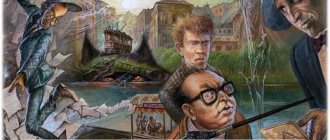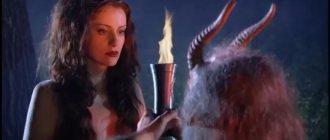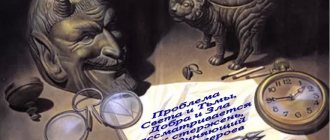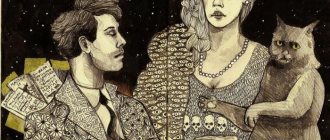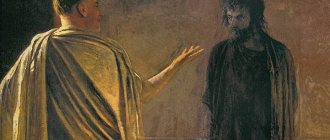Pontius Pilate and Yeshua Ha-Nozri. In the mirrors of Bulgakov studies
Commentary, as one of the main genres of literary research, has more than once become the subject of discussion on the pages of “Questions of Literature.” A special block of materials devoted to literary accuracy in working with archival materials appeared in the first issue of 2008. In the next issue, with an article by K. Isupov on the philosophical understanding of the role of the commentator in the space of reader perception, we opened a continuing column. This article by L. Yanovskaya, dedicated to the problems of modern Bulgakov studies, moves the conversation about the principles of commentary into the sphere of practical application.
Lydia YANOVSKAYA
PONTIUS PILATE AND YESHUA HA-NOZRI
In the mirrors of Bulgakov studies
Pilate
Throughout the creative history of the novel “The Master and Margarita,” there were no significant changes in the general outlines of Pilate’s interpretation: the primary source of these general outlines invariably remained F. W. Farrar’s book “The Life of Jesus Christ.”
There were no turns, and yet the figure of Pilate in the process of work was persistently filled with new meanings, deep, fluid and ambiguous. It grew, and the presence of modernity was more and more alarmingly indicated in it - mainly as Stalin’s hypnotic personality took shape and grew in parallel in life. Between both faces - the modern, living one, and the historical, legendary one - some important artistic threads were stretched.
It has already been noted that Bulgakov’s prose is polysemantic, like life itself, and for this reason seductively multidirectional. Against the background of Soviet literature, which was usually tendentious and straightforward, this was an illogical miracle, almost an oddity, and perhaps one should not be surprised that literary scholars, infused with communist scholasticism with its formal thinking, still understand the novel “The Master and Margarita” » are inferior to teenagers.
The young reader, unprejudiced and spontaneously preserving the imaginative thinking of childhood, takes from the novel as much as he can. He - if he is not disturbed by a persistent teacher who forces him to memorize the wisdom from B. Sokolov's Bulgakov Encyclopedia - in the endlessly multi-layered imagery of the novel, he joyfully grasps the top layer filled with fantasy. And sometimes he scoops up both the second and the third - deeper. And his perception is correct and absolutely devoid of falsehood, even if not very complete and not too deep.
Bulgakov scholar (and people who are completely devoid of imaginative thinking mysteriously become Bulgakov scholars) is confused by this very multidirectionality of the novel and bewildered by the charming sincerity of the intonation. In the novel, the Bulgakov scholar is looking for an unambiguous, logically explainable meaning; in order to find this meaning, he reinterprets, reinterprets the novel, adjusts it “to suit himself,” replaces the bottomless content of the great work with his own predilections or his own, often very narrow, worldview.
B. Sokolov’s main task in his “Bulgakov Encyclopedia” is to bring down on the reader all his erudition, which Berlioz would envy. Sokolov reveals the pseudonyms of politicians, writers and other historical figures, exhumes their true names - even in cases where these persons and these names are far from our plot; calculates a variety of dates that are and are not related to the novel; generously replenishes - the favorite pastime of Bulgakov scholars - lists of “sources”, without which Bulgakov supposedly could not do without, without bothering himself in the least with argumentation or even doubt. Erudition flows forth, cutting off the reader from the artistic world of the work. And all this applies not least to the interpretation of the image of Pilate in the novel “The Master and Margarita”.
Remember how Bulgakov, structuring the personality of Pontius Pilate, introduces a very important point into the dense fabric of the “ancient” chapters: the long-standing battle “at Idistavizo”, in which a young horseman, the future all-powerful procurator of Judea, took part, and listen how small the number of words and details is , how colorful, emotional, and oversaturated with meaning the descriptions of this battle are.
The picture of the battle is included in the narrative three times. At first, as if by accident: Yeshua - and this is all Yeshua - at a dramatic moment, when his life is in the balance and, it seems, he needs to think about himself and only himself, suddenly asks with great interest about Ratboy: “It would be interesting to know who crippled him?
And Pilate, unexpectedly recalling this bright moment of his youth from his memory, responds like this: “Good people rushed at him like dogs at a bear. The Germans grabbed his neck, arms, and legs. The infantry maniple fell into the bag, and if the cavalry tour had not cut in from the flank, and I commanded it, you, philosopher, would not have had to talk to the Rat-Slayer. It was in the battle of Idistavizo, in the Valley of the Maidens.”
Where is Idistaviso? What is the Valley of the Maidens? Were there statues standing there, stone women? But perhaps the reader does not need to be more precise. Idistaviso... Germans... somewhere very far from Rome and even further from Judea... Spaces gone forever, as time goes forever...
This name is vaguely familiar to Bulgakov’s peers - in the gymnasium they studied the history of Ancient Rome in detail. However, compare in the “White Guard”: “... Caius Julius Caesar, stake in cosmography and eternal hatred of astronomy from the day of this stake... and when the Jesuit order was founded, and Pompey landed, and someone else landed, and landed and landed in for two thousand years...” For readers of subsequent generations, the word became erased and became mysterious.
Having appeared in Pilate's memory once, the battle in the Valley of the Virgins immediately appears again, for the second time. Now the procurator hears his own voice, the same as once in the Valley of the Virgins: “It will never come! - Pilate suddenly shouted in such a terrible voice that Yeshua recoiled. So many years ago, in the Valley of the Virgins, Pilate shouted to his horsemen the words: “Cut them down! Slash them! The Giant Rat Slayer has been caught!”
Turma cuts in from the flank... “Cut them down!” Cut them down!” - Pilate shouts... And you see horses rearing up, heated by the galloping and battle, covered in their own and others’ blood... swords falling on the shoulders and heads of the foot Germans... you hear the snoring of horses, curses and wheezes of the chopped, furious screams of the horsemen...
And for the third time this battle will take place before the eyes of Pilate - after the execution of Yeshua: “For example, the current procurator of Judea was not a coward, but the former tribune in the legion, then, in the Valley of the Virgins, when the furious Germans almost killed the Giant Rat Slayer. But, have mercy on me, philosopher! Do you, with your intelligence, admit the idea that because of a man who committed a crime against Caesar, the procurator of Judea will ruin his career?
Now this is an attempt to come to terms with oneself. And the impossibility of coming to an agreement with oneself: “Of course, it will destroy. In the morning I wouldn’t have destroyed it yet, but now, at night, having weighed everything, I agree to destroy it.”
And the reader no longer thinks about what this strange name is - Idistavizo. The reader is immersed in thoughts about why Pilate now chickened out, betraying himself... and that these are different things... yes, yes, it turns out that these are completely different things... in the heat of battle, in full view of his comrades, where everything is so clear : The Giant Rat-Slayer was caught and you need to jump to the rescue and chop!.. and in silence, alone with yourself and with your conscience... And that Yeshua will not betray himself... and the master did not betray himself, because the master (whose image is so is frantically “rethought” by critics that it is already difficult for the reader to resist), it turns out that cowardice is not characteristic of the master either... Yes, the tormented master is frightened by a dog rushing at his feet, yes, he is terrified by the disgustingly grinding box of a tram in the cold... But to write what he knows alone in the whole world, to look into the eyes of the Prince of Darkness and decide the fate of Pilate - no, he is not afraid...
And for B. Sokolov, all these thoughts and experiences are sheer nonsense. Sokolov gives out information. He will tell in detail about the Roman commander Germanicus, who defeated the Germans in that battle. You will find out the date of birth of Germanicus, and the date of his death, and what relationship he was with the Emperor Tiberius. And, of course, the dates and various circumstances of the biography of his not so successful opponent Arminius. Although, if Bulgakov needed these characters, he probably would have brought them out, at least mentioned them, designated them somehow. But in the novel there is neither Germanicus nor Arminius.
Extra information.
(Extra information? Once upon a time, while preparing for publication the unknown story “Khan’s Fire”, my first publication from Bulgakov, I came across a chain of rare words in the story: espantons... kenkets... bosquet... From the context, however, it was clear that kenkets are some kind of lamps on the walls, espantons are edged weapons, etc. Nevertheless, having carefully searched for old dictionaries and all these words in old dictionaries, I compiled a detailed commentary. And having finished and carefully retyped it, I realized that this comment was not needed. She destroyed her work, not even leaving drafts, and never made such comments again.
Because the author - especially such a strong author as Mikhail Bulgakov - knows very well what he is doing. And if he, who from childhood remembered the charm of translated adventure novels with many mysterious words - in which we even placed the emphasis at random - wants mysteriously obscure words or names to appear in his text, do not interfere with this. Don't come between the author and the reader. A great artist does not need an interpreter.)
However, B. Sokolov does not stop there. Having further studied the novel “The Master and Margarita,” he discovers (or rather, it seems to him that he discovers in the novel) certain omissions in the biography of Pilate.
“At first glance,” Sokolov writes, “Bulgakov’s P[ontius] P[ilates] is a man without a biography...” He immediately joyfully realizes: “... but in fact, all of it is present in a hidden form in the text.”## Boris Sokolov . Decree. Op.
- Sokolov Boris. Bulgakov Encyclopedia. M.: Lockid-MYTH, 1996. []
- Mikhail Bulgakov, as usual, checked from the “Encyclopedic Dictionary” of Brockhaus and Efron: “Idistaviso is a valley near the river Weser known for the victory of Germanicus over Arminius <...> The name Idistaviso is most often interpreted according to Jacob Grimm as “Valley of the Virgins”” . But the writer, as you can see, did not load this information into the novel.[]
Want to continue reading? Subscribe for full access to the archive.
Get access
Already subscribed? Log in to access the full text.
- Author: M. A. Bulgakov
- Work: The Master and Margarita
- This essay has been copied 126,071 times
Ancient Yershalaim is described by Bulgakov with such skill that it is remembered forever. Psychologically deep, realistic images of diverse heroes, each of which is a vivid portrait. The historical part of the novel makes an indelible impression. Individual characters and crowd scenes, city architecture and landscapes are equally talentedly written by the author. Bulgakov makes readers participants in the tragic events in the ancient city.
The theme of power and violence is universal in the novel. The words of Yeshua Ha-Nozri about universal justice have their origins in Christian beliefs: “... all power is violence over people and... the time will come when there will be no power of either the Caesars or any other power. Man will move into the kingdom of truth and justice, where no power will be needed at all.”
In the dispute between Yeshua and Pontius Pilate, a clash of two ideologies occurs. Yeshua claims that people are good from birth, and that the time will come when relations between them will be built on the principles of justice and humanism. In Pilate's answers one can feel the bitterness of a man wise by experience. For a long time he has no illusions about the laws of social order and is confident that the reign of justice will never come.
The Procurator of Judea occupies a high position. He serves Caesar, but in his soul he understands all the injustice of power. As a result of internal duality, Pilate had a terrible headache that would not go away. He has already been punished for being forced to commit injustice for the sake of his position. He looks with alarm at the tramp Yeshua, who was brought to him for interrogation, who, according to a denunciation, “at the bazaar he persuaded the people to destroy the Yershalaim temple.” Pilate is shocked by the sincere kindness of this man, his calmness, the absence of humiliating fear, and especially the words of Yeshua: “It is easy and pleasant to speak the truth.” He, the great procurator, does not dare to do this. The procurator associates the sudden cessation of the debilitating headache with Yeshua’s ability to heal illnesses. But most importantly, Pilate is sure that Yeshua is not a criminal, so he wants to save him. He is not a robber or a murderer who, without a doubt, should be executed. But for the Jewish priests, Yeshua’s beliefs are worse than crimes against people. This is an attempt to discredit the authorities. Pilate knows that the world is driven by lies, anger and aggression, which means Yeshua must be executed. Saving Yeshua from execution for Pilate is tantamount to losing his position and power.
In the history of mankind, people have appeared more than once calling for living according to the laws of goodness and justice, but not one of them has yet managed to reach people and change the existing order. Bulgakov was a realist in matters of religion. But in the image of Yeshua there is a direct analogy with Christ, the savior of mankind, crucified by people.
The author creates his own hero. He is 27 years old, not 33, like Christ, his beliefs differ from those recognized as canonical by the church. The writer shows another righteous man who independently came to the ideas of good, and his sad end. Such people, seeking justice, suffering, high in spirit, honest and incorruptible, fortunately, are not found on Earth. When will society be ready to hear them? Having tragically depicted the terrible death of Yeshua, Bulgakov exalts the human feat of such martyrs, who gave their lives for the triumph of good.
Yeshua and Pilate are granted immortality by higher powers. The procurator of Judea will be remembered for the fact that he gave the order to execute Yeshua, and the name of Yeshua will forever be associated with goodness and humanity. The writer affirms the idea of the eternal balance of good and evil, light and shadow. This is the key to the harmony of life.
Check out these essays
- What does the novel “The Master and Margarita” make you think about? Personally, I read the novel “The Master and Margarita” 3 times. The debut reading, like most readers, probably caused bewilderment and questions, and was not too impressive. It was unclear: what do many generations of inhabitants of the entire planet find in this little book? In some places it is religious, in others it is fantastic, some pages are complete nonsense... After some time, I was again drawn to M. A. Bulgakov, his fantasies and insinuations, controversial historical descriptions and unclear conclusions that he allowed […]
- The role of fiction in the novel “The Master and Margarita” When people are completely robbed, like you and me, they seek salvation from an otherworldly force. M. Bulgakov. The Master and Margarita M. A. Bulgakov’s novel “The Master and Margarita” is unusual in that reality and fantasy are closely intertwined in it. Mystical heroes are immersed in the whirlpool of the turbulent Moscow life of the 30s, and this blurs the boundaries between the real world and the metaphysical world. In the guise of Woland, none other than the ruler of darkness himself, Satan, appears before us in all his glory. The purpose of his visit to [...]
- The originality of the genre of composition of the novel “The Master and Margarita” It is not for nothing that the novel “The Master and Margarita” is called the “sunset novel” of M. Bulgakov. For many years he rebuilt, supplemented and polished his final work. Everything that M. Bulgakov experienced in his lifetime - both happy and difficult - he devoted all his most important thoughts, all his soul and all his talent to this novel. And a truly extraordinary creation was born. The work is unusual, first of all, in terms of its genre. Researchers still cannot determine it. Many consider The Master and Margarita a mystical novel, citing […]
- Ideal love in the novel “The Master and Margarita” With the arrival of Margarita, the novel, which until then had resembled a ship in the depths of a storm, cut through a transverse wave, straightened the masts, set sail to the oncoming wind and rushed forward to the goal - fortunately, it was outlined, or rather, it opened - as if star in the clouds. A guiding landmark that you can rely on, like the hand of a reliable guide. Probably no one doubts that one of the main themes of the novel is the theme of “love and mercy”, “love between a man and a woman”, “true […]
- The image of Woland in the novel “The Master and Margarita” In a letter to Stalin, Bulgakov called himself a “mystical writer.” He was interested in the unknowable that makes up the soul and destiny of a person. The writer recognized the existence of the mystical in real life. The mysterious surrounds us, it is close to us, but not everyone is able to see its manifestations. The natural world and the birth of man cannot be explained by reason alone; this mystery has not yet been solved. The image of Woland represents another original interpretation by the writer of the essence of the devil as people understand it. Woland Bulgakova […]
- Moscow reality of the 20–30s in the novel “The Master and Margarita” Depicting the Moscow reality of the 20–30s in the novel “The Master and Margarita,” M. Bulgakov uses the technique of satire. The author shows crooks and scoundrels of all stripes. After the revolution, Soviet society found itself in spiritual and cultural self-isolation. According to the leaders of the state, high ideas were supposed to quickly re-educate people, make them honest, truthful builders of a “new society.” The media extolled the labor feats of the Soviet people, their devotion to the party and the people. But […]
- An essay with a plan for Bulgakov’s story “Heart of a Dog” Plan 1. Introduction 2. “There is only one counter-revolution...” (the difficult fate of Bulgakov’s story) 3. “This does not mean being human” (the transformation of Sharikov into a “new” proletarian) 4. In what danger of Sharikovism? In criticism, social phenomena or types are often named after the works that depict them. This is how “Manilovism”, “Oblomovism”, “Belikovism” and “Sharikovism” appeared. The latter is taken from M. Bulgakov’s work “The Heart of a Dog,” which served as a source of aphorisms and quotes and remains one of the most famous [...]
- Sharikov and “Sharikovism” (essay) “... the whole horror is that he no longer has a dog’s heart, but a human one. And the lousiest of all that exist in nature.” M. Bulgakov When the story “Fatal Eggs” was published in 1925, one of the critics said: “Bulgakov wants to become a satirist of our era.” Now, on the threshold of the new millennium, we can say that he became one, although he did not intend to. After all, by the nature of his talent he is a lyricist. And the era made him a satirist. M. Bulgakov was disgusted by bureaucratic forms of government […]
- The fate of people in the revolution in the novel “The White Guard” “I love this novel more than all my things,” wrote M. Bulgakov about the novel “The White Guard.” True, the pinnacle novel “The Master and Margarita” had not yet been written. But, of course, “The White Guard” occupies a very important place in the literary heritage of M. Bulgakov. This is a historical novel, a strict and sad story about the great turning point of the revolution and the tragedy of the civil war, about the fate of people in these difficult times. As if from the height of time, the writer looks at this tragedy, although the civil war has just ended. “Great [...]
- The dream of a beautiful person in the works of Gorky and Bulgakov The life of M. Gorky was unusually bright and seems truly legendary. What made it so, first of all, was the inextricable connection between the writer and the people. The talent of a writer was combined with the talent of a revolutionary fighter. Contemporaries rightly considered the writer the head of the advanced forces of democratic literature. During the Soviet years, Gorky acted as a publicist, playwright and prose writer. In his stories he reflected the new direction in Russian life. The legends about Larra and Danko show two concepts of life, two ideas about it. One […]
- The system of images in the story “Heart of a Dog” The system of images in M. Bulgakov’s story “Heart of a Dog” is a debatable issue. In my opinion, two opposing camps are clearly visible here: Professor Preobrazhensky, Doctor Bormental and Shvonder, Sharikov. Professor Preobrazhensky, no longer a young man, lives alone in a beautiful, comfortable apartment. The brilliant surgeon is engaged in profitable rejuvenation operations. But the professor plans to improve nature itself, he decides to compete with life itself and create a new person by transplanting […]
- “The Heart of a Dog” as a socio-philosophical satire on modern society I believe that M. Bulgakov received the label of “politically harmful author” from his high-ranking contemporaries completely “fairly”. He portrayed the negative side of the modern world too openly. Not a single work of Bulgakov, in my opinion, has had such popularity in our time as “The Heart of a Dog.” Apparently, this work aroused interest among readers of the widest strata of our society. This story, like everything that Bulgakov wrote, fell into the category of prohibited. I'll try to reason […]
- The image of Professor Preobrazhensky in the story “Heart of a Dog” The assessment of the representatives of the intelligentsia in Bulgakov’s story is far from clear. Professor Preobrazhensky is a famous scientist in Europe. He is searching for means to rejuvenate the human body and has already achieved significant results. The professor is a representative of the old intelligentsia and professes the principles of morality and ethics. Everyone, according to Philip Philipovich, in this world should mind their own business: in the theater - sing, in the hospital - operate. Then there will be no destruction. And to achieve material [...]
- Soviet Moscow and the “new man” in Bulgakov’s story “The Heart of a Dog” Bulgakov knew how to talentedly combine the contradictions of the era into one whole and emphasize their interconnections. The writer in his story “Heart of a Dog” showed phenomena and characters in all their contradictions and complexity. The theme of the story is man as a social being, over whom a totalitarian society and state are conducting a grandiose inhumane experiment, embodying with cold cruelty the brilliant ideas of their theoretic leaders. The personality is destroyed, crushed, all its centuries-old achievements - spiritual culture, faith, […]
- Fantastic and real in the story “Heart of a Dog” One of Bulgakov’s best works was the story “Heart of a Dog”, written in 1925. Representatives of the authorities immediately assessed it as a poignant pamphlet on modernity and banned its publication. The theme of the story “Heart of a Dog” is the image of man and the world in a difficult transitional era. On May 7, 1926, a search was carried out in Bulgakov’s apartment, a diary and a manuscript of the story “Heart of a Dog” were confiscated. Attempts to return them led nowhere. Later, the diary and story were returned, but Bulgakov burned the diary and more […]
- Characteristics of Yaroslavna in “The Tale of Igor’s Campaign” with quotes “The Tale of Igor’s Campaign” is an amazing, wise and incredibly talented monument of ancient Russian literature. The images of strong men are depicted in it very clearly and clearly. But a Russian woman, who does not have physical strength and power, is not lost against their background. Yaroslavna is the wife of Prince Igor, a young, fragile and tender woman. She learned about the death of the army, the captivity of her husband, and mourns alone. But is he grieving? Yaroslavna's lament tells the reader a lot about the women of Ancient Rus'. Those who are not familiar with the legends […]
- Chichikov’s acquaintance with the city of NN “A rather beautiful spring chaise drove through the gates of the hotel in the provincial town of NN... In the chaise sat a gentleman, not handsome, but not of bad appearance, neither too fat nor too thin; One cannot say that he is old, but not that he is too young. His entry made absolutely no noise in the city and was not accompanied by anything special.” This is how our hero, Pavel Ivanovich Chichikov, appears in the city. Let us, following the author, get to know the city. Everything tells us that this is a typical provincial [...]
- The image of the people's defender Grisha Dobrosklonov The image of the "people's defender". He is seminarian Grisha Dobrosklonov, the son of a “unrequited farm laborer” and a rural sexton who lived “poorer than the last seedy peasant.” Hungry childhood and harsh youth brought him closer to the people, accelerated his spiritual maturation and determined Grisha’s life path: ...at the age of fifteen, Gregory already knew for sure. What will live for the happiness of the wretched and dark native corner. In many of his character traits, Grisha resembles Dobrolyubov. Like Dobrolyubov, Grisha Dobroklonov is a fighter for [...]
- Autumn in the lyrics of Russian poets (based on the poems “Autumn” by Lermontov and “Autumn Evening” by Tyutchev) The nature of the native country is an inexhaustible source of inspiration for poets, musicians, and artists. They all recognized themselves as part of nature, “breathed the same life with nature,” as F.I. Tyutchev said. Other wonderful lines belong to him: Not what you think, nature: Not a cast, not a soulless face - It has a soul, it has freedom, It has love, it has a language... It was Russian poetry that was able to penetrate into the soul of nature, to hear its language. In the poetic masterpieces of A. […]
- Artistic detail and its role in creating the image of Manilov Nikolai Vasilyevich Gogol noted that the main theme of “Dead Souls” was contemporary Russia. The author believed that “there is no other way to direct society or even an entire generation towards the beautiful until you show the full depth of its real abomination.” That is why the poem presents a satire on the local nobility, bureaucracy and other social groups. The composition of the work is subordinated to this task of the author. The image of Chichikov traveling around the country in search of the necessary connections and wealth allows N.V. Gogol […]
